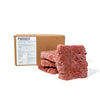When it Comes to Feeding Your Dog a Raw Diet, Variety is More Than Just a Nice-to-Have; It’s a Must for Optimal Health
While many pet parents focus on getting the right balance of muscle meat, bones, and organ meats, one key aspect often overlooked is protein rotation. Rotating proteins offers a host of benefits for your dog’s overall well-being, from providing a wider array of nutrients to reducing the risk of food sensitivities. In this blog, we’ll dive into why rotating proteins is essential for your dog’s raw diet and how it can help keep them healthy and vibrant.
What Does Protein Rotation Mean?
Protein rotation refers to the practice of regularly changing the types of meat your dog eats, instead of sticking to the same protein source day in and day out. For example, one week your dog might be eating chicken, and the next, you might switch to beef or lamb. The goal is to provide your dog with a variety of proteins to ensure they’re getting a broad spectrum of amino acids, essential fatty acids, and other nutrients that support their health.
In nature, animals don’t consume the same meat every day. Wild canines eat whatever prey is available, which naturally leads to a diet with a variety of proteins. By mimicking this practice in your dog’s raw diet, you’re giving them a more balanced, nutrient-rich eating plan that supports long-term health.
The Benefits of Rotating Proteins for Your Dog
1. A Broader Nutritional Profile
Each protein source offers its own unique set of amino acids, vitamins, minerals, and fatty acids. For instance, chicken is high in certain amino acids that are beneficial for muscle growth, while beef provides more iron and zinc. Fish like salmon are rich in omega-3 fatty acids, which are excellent for skin, coat, and joint health.
By rotating proteins, you ensure that your dog is getting a wide range of nutrients that might be absent in any one meat source. This diversity of nutrition helps keep their body in balance, supporting their immune system, metabolism, and overall vitality.
2. Reducing the Risk of Food Sensitivities and Allergies
Just like humans, dogs can develop sensitivities or allergies to certain foods over time. If you feed your dog the same protein source every day, they may become more prone to developing food sensitivities or allergies to that protein. This is especially true for dogs that are fed a diet consisting of just one protein source, like chicken, for an extended period.
By rotating proteins, you reduce the likelihood that your dog will develop a sensitivity to a specific protein. This practice helps prevent the buildup of antibodies against a particular food and can keep your dog’s digestive system healthy and responsive to a variety of proteins.
3. Improving Digestion and Absorption of Nutrients
Variety in protein sources also supports your dog’s digestion and nutrient absorption. Different proteins contain different levels of fat, fiber, and other nutrients that affect how your dog’s digestive system works. By rotating proteins, you encourage your dog’s digestive system to stay flexible and adaptable, improving overall digestion.
Additionally, this variety ensures that your dog is receiving a wider array of essential fatty acids and amino acids, which are key for muscle repair, immune function, and energy production. When your dog is fed a balanced diet with plenty of protein diversity, their body is better equipped to digest and absorb these nutrients.
4. Supporting a Balanced Immune System
Rotating proteins helps support your dog’s immune system by offering a broader range of vitamins and minerals that boost immune function. For example, lamb is rich in selenium, which is known to enhance immune response, while turkey is high in niacin, which supports cellular health. By giving your dog a variety of proteins, you ensure they get the full spectrum of immune-boosting nutrients.
A healthy immune system is vital for dogs, especially as they age or if they’re prone to health issues. Protein rotation strengthens the body’s natural defenses by providing it with the building blocks it needs to fight off infections, inflammation, and other health problems.
5. Supporting Joint and Bone Health
Different proteins contain varying amounts of nutrients that are vital for joint and bone health. For example, chicken is an excellent source of glucosamine, which helps maintain joint health, while beef provides more calcium and phosphorus, both essential for strong bones.
By rotating proteins, you provide your dog with the full range of nutrients necessary for joint, bone, and cartilage health. Regularly changing up the proteins in your dog’s diet ensures that their body gets the vitamins and minerals needed to maintain mobility, especially as they age or if they’re highly active.
How to Rotate Proteins in Your Dog's Diet
Aim for 3–4 Different Proteins Each Month
To ensure a balanced and varied diet, aim to rotate at least 3–4 different protein sources each month. This might include chicken, beef, lamb, turkey, fish, and pork. The more variety you provide, the better, as each protein offers a different set of nutrients.
Conclusion
Rotating proteins in your dog’s raw diet is one of the most effective ways to ensure they’re getting the nutrients they need to stay healthy and strong. By providing variety in their meals, you’re helping prevent food sensitivities, supporting a balanced immune system, and promoting better digestion, joint health, and vitality. It’s an easy practice that can make a big difference in your dog’s long-term health and well-being.
Ready to give your dog the variety they need? Check out RawFedK9’s wide selection of proteins and start rotating today!






